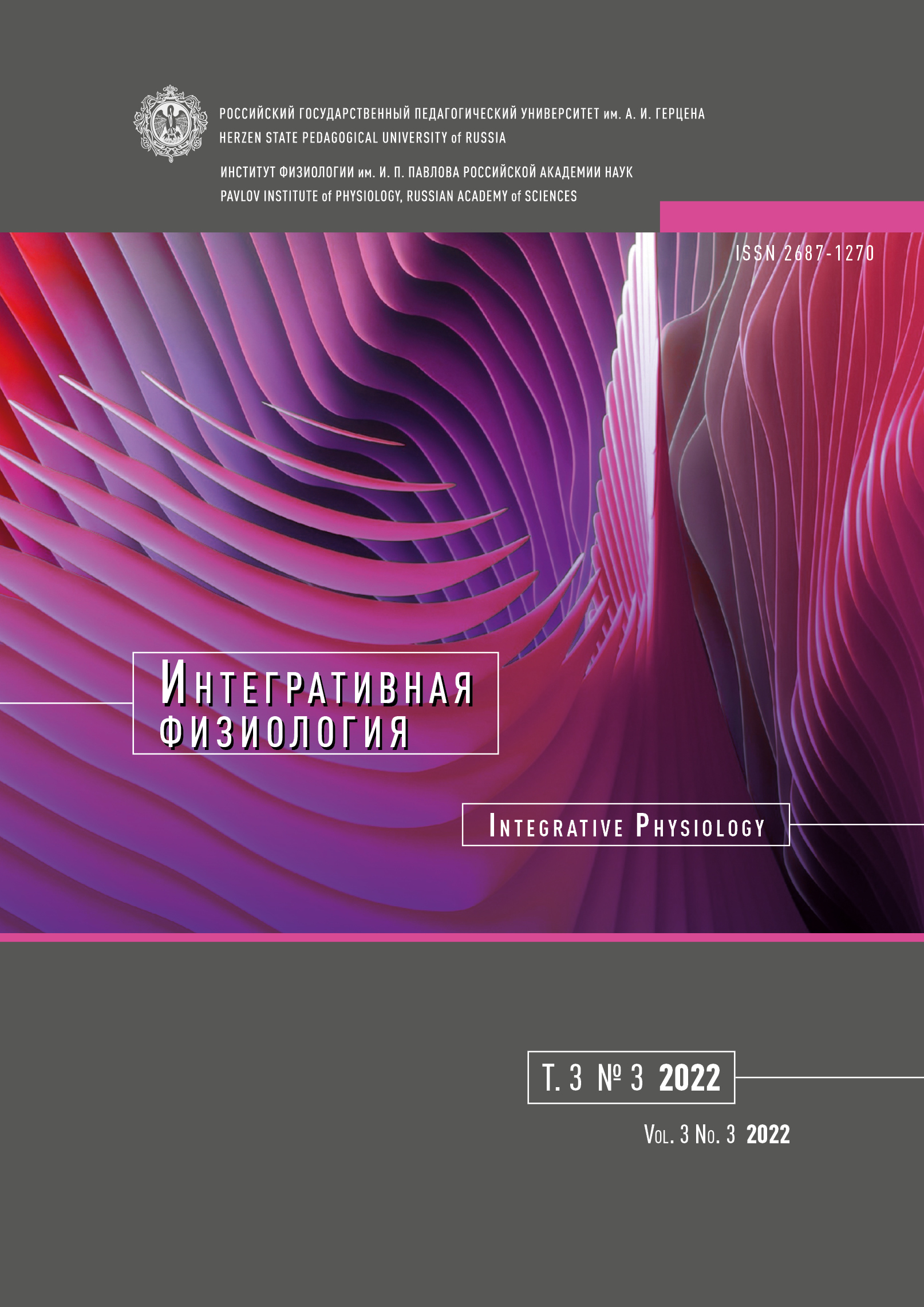Mechanism of NO-mediated dilation of pial arteries in response to acetylcholine in aging rats
DOI:
https://doi.org/10.33910/2687-1270-2022-3-3-367-377Keywords:
aging, endothelial dysfunction, pial vessels, NO-mediated dilation, nitric oxide synthasesAbstract
The article reports the results of the study focusing on age-related changes in the contribution of NO, synthesized by various forms of nitric oxide synthases (NOS) and exogenous L-arginine in acetylcholine-induced dilation of cerebral vessels in rats. A comparative assessment of the responses of pial arteries of various diameters to acetylcholine chloride (ACh, 10–7 M, 8 min) was carried in the absence and in the presence of NOS blockade and exogenous L-arginine (0.25 mM, 30 min) in Sprague-Dawley rats aged 4 and 18 months. NOS blockade was performed by using a non-selective NOS inhibitor (L-NAME, 10–3 M, 12 min) and an inducible NOS inhibitor (aminoguanidine, 1 mM, 10 min). The change in the number and degree of arterial dilation was assessed by measuring the width of the erythrocyte flow in three separate groups of arteries: small (<20 μm in diameter), medium (20–40 μm), and large (>40 μm). It was found that in 18-month-old rats, the contribution of NO, synthesized by constitutive forms of NOS, decreases in the implementation of ACh-mediated endothelium-dependent dilatatory reactions in small and medium pial arteries, while an increase was observed for pial. At the same time, the contribution of inducible NOS to dilation of all types of arteries is on the increase. These processes are accompanied by a decrease in the bioavailability of exogenous L-arginine for NOS.
References
Arvanitakis, Z., Capuano, A. W., Leurgans, S. E. et al. (2016) Relation of cerebral vessel disease to Alzheimer’s disease dementia and cognitive function in elderly people: A cross-sectional study. The Lancet. Neurology, vol. 15, no. 9, pp. 934–943. https://doi.org/10.1016/S1474-4422(16)30029-1 (In English)
Berkowitz, D. E., White, R., Li, D. et al. (2003) Arginase reciprocally regulates nitric oxide synthase activity and contributes to endothelial dysfunction in aging blood vessels. Circulation, vol. 108, no. 16, pp. 2000–2006. https://doi.org/10.1161/01.CIR.0000092948.04444.C7 (In English)
Bierhansl, L., Conradi, L.-C., Treps, L. et al. (2017) Central role of metabolism in endothelial cell function and vascular disease. Physiology, vol. 32, no. 2, pp. 126–140. https://doi.org/10.1152/physiol.00031.2016 (In English)
Cau, S. B., Carneiro, F. S., Tostes, R. C. (2012) Differential modulation of nitric oxide synthases in aging: Therapeutic opportunities. Frontiers in Physiology, vol. 3, article 218. https://doi.org/10.3389/fphys.2012.00218 (In English)
Cernadas, M. R., de Miguel, L. S., García-Durán, M. et al. (1998) Expression of constitutive and inducible nitric oxide synthases in the vascular wall of young and aging rats. Circulation Research, vol. 83, no. 3, pp. 279–286. https://doi.org/10.1161/01.res.83.3.279 (In English)
Cinelli, M. A., Do, H. T., Miley, G. P., Silverman, R. B. (2020) Inducible nitric oxide synthase: Regulation, structure, and inhibition. Medicinal Research Reviews, vol. 40, no. 1, pp. 158–189. https://doi.org/10.1002/med.21599 (In English)
Clemente, G. S., van Waarde, A., Antunes, I. F. et al. (2020) Arginase as a potential biomarker of disease progression: A molecular imaging perspective. International Journal of Molecular Sciences, vol. 21, no. 15, article 5291. https://doi.org/10.3390/ijms21155291. (In English)
Cuadrado-Godia, E., Dwivedi, P., Sharma, S. et al. (2018) Cerebral small vessel disease: A review focusing on pathophysiology, biomarkers, and machine learning strategies. Journal of Stroke, vol. 20, no. 3, pp. 302–320. https://doi.org/10.5853/jos.2017.02922 (In English)
De Silva, T. M., Faraci, F. M. (2020) Contributions of aging to cerebral small vessel disease. Annual Review of Physiology, vol. 82, pp. 275–295. https://doi.org/10.1146/annurev-physiol-021119-034338 (In English)
Fujii, N., Meade, R. D., Alexander, L. M. et al. (2016) iNOS-dependent sweating and eNOS-dependent cutaneous vasodilation are evident in younger adults, but are diminished in older adults exercising in the heat. Journal of Applied Physiology, vol. 120, no. 3, pp. 318–327. https://doi.org/10.1152/japplphysiol.00714.2015 (In English)
Gambardella, J., Khondkar, W., Morelli, M. B. et al. (2020) Arginine and endothelial function. Biomedicines, vol. 8, no. 8, article 277. https://doi.org/10.3390/biomedicines8080277 (In English)
Katusic, Z. S. (2007) Mechanisms of endothelial dysfunction induced by aging: Role of arginase I. Circulation Research, vol. 101, no. 7, pp. 640–641. https://doi.org/10.1161/CIRCRESAHA.107.162701 (In English)
Luiking, Y. C., Ten Have, G. A. M., Wolfe, R. R., Deutz, N. E. P. (2012) Arginine de novo and nitric oxide production in disease states. American Journal of Physiology Endocrinology and Metabolism, vol. 303, no. 10, pp. E1177–E1189. https://doi.org/10.1152/ajpendo.00284.2012 (In English)
Mazlan, M., Hamezah, H. S., Taridi, N. M. et al. (2017) Effects of aging and tocotrienol-rich fraction supplementation on brain arginine metabolism in rats. Oxidative Medicine and Cellular Longevity, vol. 2017, article 6019796. https://doi.org/10.1155/2017/6019796 (In English)
Mistry, S. K., Greenfeld, Z., Morris, S. M. Jr., Baylis, C. (2002) The ‘intestinal-renal’ arginine biosynthetic axis in the aging rat. Mechanisms of Ageing and Development, vol. 123, no. 8, pp. 1159–1165. https://doi.org/10.1016/s0047-6374(02)00003-9 (In English)
Morris, S. M. Jr. (2007) Arginine metabolism: Boundaries of our knowledge. The Journal of Nutrition, vol. 137, no. 6, pp. 1602S–1609S. https://doi.org/10.1093/jn/137.6.1602S (In English)
Olchanheski, L. R. Jr., Sordi, R., Oliveira, J. G. et al. (2018) The role of potassium channels in the endothelial dysfunction induced by periodontitis. Journal of Applied Oral Science, vol. 26, article e20180048. https://doi.org/10.1590/1678-7757-2018-0048 (In English)
Pozhilova, E. V., Novikov, V. E. (2015) Sintaza oksida azota i endogennyj oksid azota v fiziologii i patologii kletki [Physiological and pathological value of cellular synthase of nitrogen oxide and endogenous nitrogen oxide]. Vestnik Smolenskoj gosudarstvennoj meditsinskoj akademii — Vestnik of the Smolensk State Medical Academy, vol. 14, no. 4, pp. 35–41. (In Russian)
Santhanam, L., Christianson, D. W., Nyhan, D., Berkowitz, D. E. (2008) Arginase and vascular aging. Journal of Applied Physiology, vol. 105, no. 5, pp. 1632–1642. https://doi.org/10.1152/japplphysiol.90627.2008 (In English)
Shin, S., Mohan, S., Fung, H.-L. (2011) Intracellular L-arginine concentration does not determine NO production in endothelial cells: Implications on the “L-arginine paradox”. Biochemical and Biophysical Research Communications, vol. 414, no. 4, pp. 660–663. https://doi.org/10.1016/j.bbrc.2011.09.112 (In English)
Sindler, A. L., Delp, M. D., Reyes, R. et al. (2009) Effects of ageing and exercise training on eNOS uncoupling in skeletal muscle resistance arterioles. The Journal of Physiology, vol. 587, no. 15, pp. 3885–3897. https://doi.org/10.1113/jphysiol.2009.172221 (In English)
Tang, W. H. W., Wang, Z., Cho, L. et al. (2009) Diminished global arginine bioavailability and increased arginine catabolism as metabolic profile of increased cardiovascular risk. Journal of the American College of Cardiology, vol. 53, no. 22, pp. 2061–2067. https://doi.org/10.1016/j.jacc.2009.02.036 (In English)
Toth, P., Tarantini, S., Csiszar, A., Ungvari, Z. (2017) Functional vascular contributions to cognitive impairment and dementia: Mechanisms and consequences of cerebral autoregulatory dysfunction, endothelial impairment, and neurovascular uncoupling in aging. American Journal of Physiology. Heart and Circulatory Physiology, vol. 312, no. 1, pp. H1–H20. https://doi.org/10.1152/ajpheart.00581.2016 (In English)
Ungvari, Z., Tarantini, S., Donato, A. J. et al. (2018) Mechanisms of vascular aging. Circulation Research, vol. 123, no. 7, pp. 849–867. https://doi.org/10.1161/CIRCRESAHA.118.311378 (In English)
Xiong, Y., Fru, M. F., Yu, Y. et al. (2014) Long term exposure to L-arginine Accelerates endothelial cell senescence through arginase-II and S6K1 signaling. Aging, vol. 6, no. 5, pp. 369–379. https://doi.org/10.18632/aging.100663 (In English)
Xu, H., Li, S., Liu, Y.-S. (2022) Nanoparticles in the diagnosis and treatment of vascular aging and related diseases. Signal Transduction and Targeted Therapy, vol. 7, no. 1, article 231. https://doi.org/10.1038/s41392-022-01082-z (In English)
Downloads
Published
Issue
Section
License
Copyright (c) 2022 Oksana P. Gorshkova

This work is licensed under a Creative Commons Attribution-NonCommercial 4.0 International License.
The work is provided under the terms of the Public Offer and of Creative Commons public license Creative Commons Attribution 4.0 International (CC BY 4.0).
This license permits an unlimited number of users to copy and redistribute the material in any medium or format, and to remix, transform, and build upon the material for any purpose, including commercial use.
This license retains copyright for the authors but allows others to freely distribute, use, and adapt the work, on the mandatory condition that appropriate credit is given. Users must provide a correct link to the original publication in our journal, cite the authors' names, and indicate if any changes were made.
Copyright remains with the authors. The CC BY 4.0 license does not transfer rights to third parties but rather grants users prior permission for use, provided the attribution condition is met. Any use of the work will be governed by the terms of this license.







